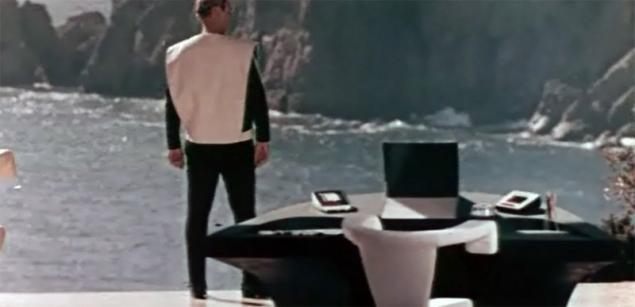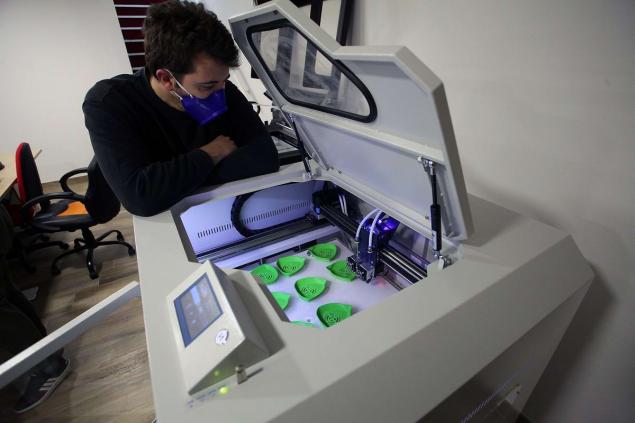277
What exactly predicted the science fiction Soviet school Brothers Strugatsky
The works of the Strugatsky brothers have long been an integral part of our culture and entered the golden fund of science fiction. At the same time, oddly enough, technical progress interested writers not in the first place.

The main theme of their novels has always been the ethical and moral problems that the people of the future will face. “Fantasts are poor soothsayers, soothsayers,” modestly lamented Boris Strugatsky.

But this did not prevent Strugatsky from taking his place among the geniuses who were able to amazingly accurately predict many epochal discoveries and achievements of the XXI century. Here they come true predictions from the classics of Soviet fiction.
“If I saw further than others, it was because I stood on the shoulders of giants,” said Isaac Newton in one of his letters. Therefore, before we talk about the conjectures of the Strugatskys, we pay tribute to other famous soothsayers.

GettyImages This list could be truly endless. But the format of the article allows you to mention only the most famous. Let’s start with one of the founders of science fiction – Jules Verne. Dangerous adventures, fantastic fiction and real scientific facts from the pages of his novels led and inspired more than one generation of inventors and scientists.

Ahead of time, Jules Verne was the first to talk about space exploration. In his works, you can find a description of computers, scuba dives, helicopters, aircraft and high-speed submarines built a century later.

Born a century later, the author of Solaris, Stanislav Lem, became the first science fiction writer to predict the end of the age of paper books. Reading his prophetic words on the screen of the familiar reader from Kindle, it is very difficult not to admire the prophetic gift of the writer.

And further proof that the gift of foresight can materialize the future. Pictured is a shot from the 1967 Soviet film The Andromeda Nebula. Surprisingly, Steve Jobs still goes to school at this time, and the first public laptop “Osborne 1” will appear in the US only 14 years later.
The novel “Beetle in the Anthill” was written in 1979. In it, we find the Big Planetary Information Center, a global repository of diverse information, in which you can find addresses, telephones, scientific articles.

What is the equivalent of Wikipedia? True, the effectiveness of the modern Internet Strugatsky underestimated. Maxim Kammerer, for example, waits for an answer to one of his requests for at least two hours.
Against the background of the latest news that Tesla with a sleeping driver tried to escape from the police, the description of an unmanned vehicle in the novel Predatory Things of the Century (1964) looks interesting.

GettyImages: I watched him approach his long car, collapse in the seat, dig into the driver's remote, lean back and seem to doze off. The car gently rolled through the square and, gaining speed, disappeared in the shade and greenery of the side street.”
Rave parties of Tyagotey to social fiction, Strugatsky predicted not only technical, but also many everyday phenomena of the XXI century. Predatory Things of the Century (1965) was conceived as a satirical parody of the world of capitalist prosperity. But an attentive reader will easily find in it pictures from modern life.
“Red is blue is green, red is blue is green... Stiffened tilted faces, black open mouths, fixed gazed eyes. They didn’t even blink under the plafonds... It was very quiet, and I shuddered when a shrill female voice nearby shouted, “Walk!”

GettyImages And now dozens of voices responded: “Tremble! Shock! People on the sidewalks along the perimeter of the square began to quietly clap their hands in the beat of flashes of plafonds and chanted in even voices: “Tremble! Tremble! Tremble!
Someone hit my back with a sharp elbow. I was piled on, pushing forward, to the center of the square, under the ceilings. I took a step, another, and then moved through the crowd, pushing the numb people. Two teenagers, frozen like icicles, suddenly rabidly clasped, convulsively grabbing each other, scratching and stabbing with all their might, but their still faces were still thrown back to the flashing sky.
In vitro meat 3D printers can print almost anything. Including protective masks. And the three-dimensional printing of food does not look fantastic at all. Nevertheless, its results lose to real products in taste. Strugatsky were able to predict this in 1962, when the fantastic story “Distant Rainbow” was published.

GettyImages "And how unpleasant it is after two years of abundance to return to synthetic food, to artificial steaks, to pears with a toothpaste flavor, to chlorella "rural soups", to lamb quasibiotic cutlets and other miracles of synthesis, if they are wrong ..."
Paintball Lyapnik, which is nothing more than a paintball rifle, is described by the Strugatskys in the novel The Predatory Things of the Century. It was 17 years before the first paintball battle.

GettyImages: It was sort of a toy machine - with a handy corrugated handle and a flat rectangular canister that was inserted from the bottom like a shop.
- - What is this thing? - I asked.
"Lapnik," he said sullenly. - Give me that. I gave him the toy.
"Lapnik," I said. - Which is what they say. What if you hit me?
Skype, Zoom, Discord, WeChat... Video conferencing programs have firmly entered our lives. And in Strugatsky’s books, they are best described by a young man from a backward planet (The Boy from the Underworld, 1974).

GettyImages: He sits in front of his screens, on each screen – snout, or even two, and he talks to all these snouts. I was stabbed like a knife. I pictured myself frenzied up there on the hill, throwing a tantrum, and he sits here in the cool, looking at it all through the screen and giggling.
In conclusion, we add that the descendants of the legendary science fiction writers posted the works of the Strugatsky brothers in free access. And now we can all legally get acquainted with their extensive creative heritage online.

The main theme of their novels has always been the ethical and moral problems that the people of the future will face. “Fantasts are poor soothsayers, soothsayers,” modestly lamented Boris Strugatsky.

But this did not prevent Strugatsky from taking his place among the geniuses who were able to amazingly accurately predict many epochal discoveries and achievements of the XXI century. Here they come true predictions from the classics of Soviet fiction.
“If I saw further than others, it was because I stood on the shoulders of giants,” said Isaac Newton in one of his letters. Therefore, before we talk about the conjectures of the Strugatskys, we pay tribute to other famous soothsayers.

GettyImages This list could be truly endless. But the format of the article allows you to mention only the most famous. Let’s start with one of the founders of science fiction – Jules Verne. Dangerous adventures, fantastic fiction and real scientific facts from the pages of his novels led and inspired more than one generation of inventors and scientists.

Ahead of time, Jules Verne was the first to talk about space exploration. In his works, you can find a description of computers, scuba dives, helicopters, aircraft and high-speed submarines built a century later.

Born a century later, the author of Solaris, Stanislav Lem, became the first science fiction writer to predict the end of the age of paper books. Reading his prophetic words on the screen of the familiar reader from Kindle, it is very difficult not to admire the prophetic gift of the writer.

And further proof that the gift of foresight can materialize the future. Pictured is a shot from the 1967 Soviet film The Andromeda Nebula. Surprisingly, Steve Jobs still goes to school at this time, and the first public laptop “Osborne 1” will appear in the US only 14 years later.
The novel “Beetle in the Anthill” was written in 1979. In it, we find the Big Planetary Information Center, a global repository of diverse information, in which you can find addresses, telephones, scientific articles.

What is the equivalent of Wikipedia? True, the effectiveness of the modern Internet Strugatsky underestimated. Maxim Kammerer, for example, waits for an answer to one of his requests for at least two hours.
Against the background of the latest news that Tesla with a sleeping driver tried to escape from the police, the description of an unmanned vehicle in the novel Predatory Things of the Century (1964) looks interesting.

GettyImages: I watched him approach his long car, collapse in the seat, dig into the driver's remote, lean back and seem to doze off. The car gently rolled through the square and, gaining speed, disappeared in the shade and greenery of the side street.”
Rave parties of Tyagotey to social fiction, Strugatsky predicted not only technical, but also many everyday phenomena of the XXI century. Predatory Things of the Century (1965) was conceived as a satirical parody of the world of capitalist prosperity. But an attentive reader will easily find in it pictures from modern life.
“Red is blue is green, red is blue is green... Stiffened tilted faces, black open mouths, fixed gazed eyes. They didn’t even blink under the plafonds... It was very quiet, and I shuddered when a shrill female voice nearby shouted, “Walk!”

GettyImages And now dozens of voices responded: “Tremble! Shock! People on the sidewalks along the perimeter of the square began to quietly clap their hands in the beat of flashes of plafonds and chanted in even voices: “Tremble! Tremble! Tremble!
Someone hit my back with a sharp elbow. I was piled on, pushing forward, to the center of the square, under the ceilings. I took a step, another, and then moved through the crowd, pushing the numb people. Two teenagers, frozen like icicles, suddenly rabidly clasped, convulsively grabbing each other, scratching and stabbing with all their might, but their still faces were still thrown back to the flashing sky.
In vitro meat 3D printers can print almost anything. Including protective masks. And the three-dimensional printing of food does not look fantastic at all. Nevertheless, its results lose to real products in taste. Strugatsky were able to predict this in 1962, when the fantastic story “Distant Rainbow” was published.

GettyImages "And how unpleasant it is after two years of abundance to return to synthetic food, to artificial steaks, to pears with a toothpaste flavor, to chlorella "rural soups", to lamb quasibiotic cutlets and other miracles of synthesis, if they are wrong ..."
Paintball Lyapnik, which is nothing more than a paintball rifle, is described by the Strugatskys in the novel The Predatory Things of the Century. It was 17 years before the first paintball battle.

GettyImages: It was sort of a toy machine - with a handy corrugated handle and a flat rectangular canister that was inserted from the bottom like a shop.
- - What is this thing? - I asked.
"Lapnik," he said sullenly. - Give me that. I gave him the toy.
"Lapnik," I said. - Which is what they say. What if you hit me?
Skype, Zoom, Discord, WeChat... Video conferencing programs have firmly entered our lives. And in Strugatsky’s books, they are best described by a young man from a backward planet (The Boy from the Underworld, 1974).

GettyImages: He sits in front of his screens, on each screen – snout, or even two, and he talks to all these snouts. I was stabbed like a knife. I pictured myself frenzied up there on the hill, throwing a tantrum, and he sits here in the cool, looking at it all through the screen and giggling.
In conclusion, we add that the descendants of the legendary science fiction writers posted the works of the Strugatsky brothers in free access. And now we can all legally get acquainted with their extensive creative heritage online.
Why not ignore your parents’ calls
What to Tell Your Spouse If He Wants Meat Instead of Sausages for Lunch























